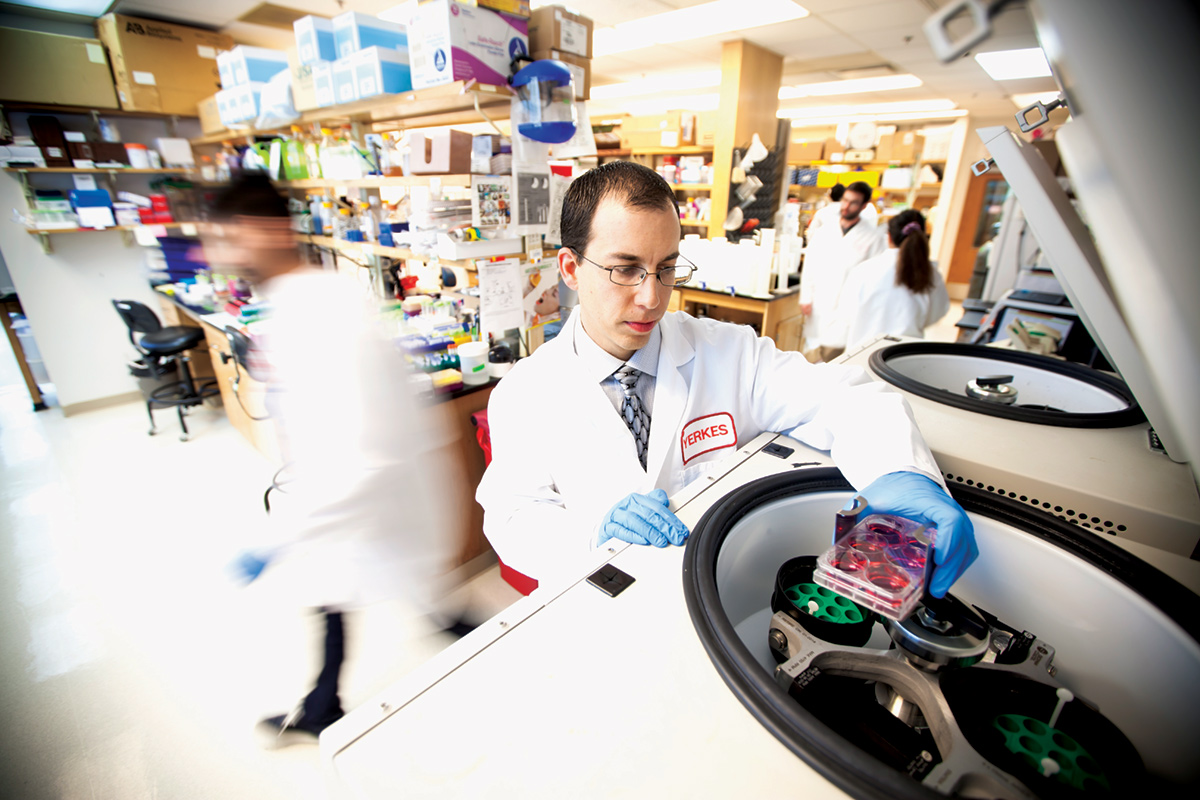When Miracle Drugs Stop Working
In the war against antibiotic resistance, scientists fear the bacteria are winning—but not for long

Kay Hinton
Penicillin was hailed as a "miracle drug" when it went into widespread use in the early 1940s, and with good reason.
Before then, even simple infections frequently led to more serious illness, even death. But with the emergence of antibiotic-resistant bacteria in recent years, medical science could find itself back at square one again—but a group of Emory researchers is determined to prevent that from happening.
According to David Weiss, director of the Emory Antibiotic Resistance Center (ARC), there are patients in hospitals around the world who are grappling with infections that no antibiotic will cure. In the US, the Centers for Disease Control and Prevention (CDC) reports there are 2 million antibiotic-resistant infections every year resulting in 23,000 deaths.
Weiss and other ARC researchers are investigating ways to alleviate this situation, brought about by the conspicuous overuse of the miracle drug and its progeny, which in turn has led to bacteria developing an immunity to antibiotics.
“For decades, antibiotics have been overprescribed for patients,” Weiss explains. “Antibiotics have even been added to some household soaps.” A common use of antibiotics is in livestock feed, accounting for the majority of all antibiotics consumed in the US, he says. “Antibiotics aren’t used only when the animals are sick, they make the animals gain weight as well.”
In addition, according to Weiss, few pharmaceutical companies have shown an interest in researching new antibiotics, which are costly to develop and don’t offer a big financial payback compared to so-called “blockbuster” drugs.
The ARC is staffed by a diverse array of experts that includes basic scientists and researchers, clinicians, epidemiologists, clinical microbiologists, and people involved in infection control and antibiotic stewardship at hospitals, says Weiss.
“We follow a multidisciplinary approach because solving the problem will require new methods and new ways of looking at things that cross traditional boundaries,” he notes.
Weiss’s lab is one of several at ARC focused on understanding the mechanisms of both antibiotic resistance and virulence. This is important because “if you can inhibit or block the way that bacteria resists antibiotics, they should be sensitive to the antibiotics once again,” he says.
One strategy already in use involves the use of chemical inhibitors. Bacteria secrete a substance called beta-lactamase that enables them to resist penicillin. By administering beta-lactamase inhibitors along with penicillin, resistance is blocked and bacteria are sensitive to penicillin again.
“Theoretically, this approach could be applied to other antibiotics as well,” says Weiss.
Last Line of Defense
Historically, gonorrhea has developed resistance to every antibiotic used against it, and we are now left with one class of drugs with activity against gonorrhea: the third generation cephalosporins. However, this last line of defense probably won’t last much longer, according to Carlos del Rio, principal investigator and director of the Gonococcal Isolate Surveillance Project (GISP) Regional Laboratory in Atlanta, an ARC partner. Del Rio has been documenting the growing antibiotic resistance of
N. gonorrhoeae for nearly 20 years.
Gonorrhea is the most commonly reported sexually transmitted infection and strikes an estimated 700,000 Americans every year and more than 100 million worldwide.
“The dwindling number of drugs that kill the bacteria must be used carefully and thoughtfully,” he says. “Information from GISP is used by CDC in issuing recommendations for treatment. The 2015 version of the CDC STD Treatment Guidelines, chaired by Kimberly Workowski, professor of medicine in the Division of Infectious diseases, now recommends for treatment of gonorrhea that ceftriaxone be administered by injection along with a second type of antibiotic given as pills.”
We desperately need new antibiotics to fight infections, adds del Rio, who supports the idea of government-supported financial incentives for pharmaceutical companies to develop new antibiotics.
Looking to Nature
ARC faculty member Cassandra Quave heads the Quave Research Group. “Our strength is in the early discovery process,” she says of her research team, which studies medicinal plant extracts and natural products isolated from those extracts to treat multidrug-resistant bacteria.
Plants offer a rich potential resource for medicines, she says. “They deal with bacterial and fungal pathogens on a regular basis in their environments. In response to those threats, plants have developed very complex biosynthetic pathways that create antimicrobial molecules.
“My lab takes an ethnobotanical approach to drug discovery, meaning that we look to traditions of medical usage of plants for the treatment of infectious disease in different forms of traditional medicine and folk medicine.”
Quave’s lab is also pursuing ways to contain the virulence of infections by disrupting the bacterial communication system, which plays an important role in bacteria’s ability to create toxins. With a staph infection, for example, “it’s not the actual bacteria cells that make you sick or kill you, it’s all the toxins they create and release into your body that break down your tissues and your blood cells and other structures.”
One significant recent discovery by Quave’s research team is an extract derived from the European chestnut that effectively blocks MRSA’s signaling system and disarms the bacteria. Biofilm is under Quave’s microscope, too.
“Antibiotic resistance is a major threat to human health,” Quave adds, “and if left unchecked we’re going to see a complete collapse of the medical system, so it’s a critical area of research.



